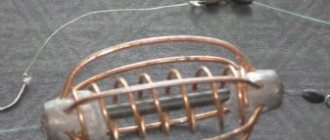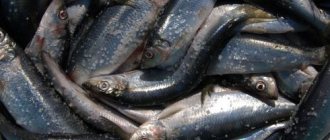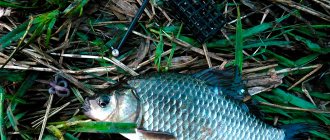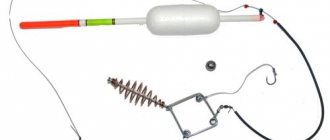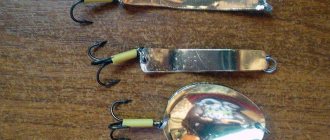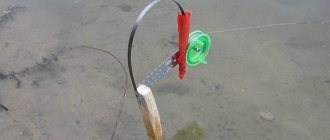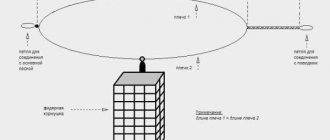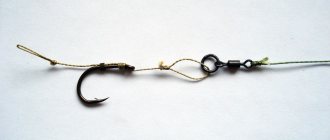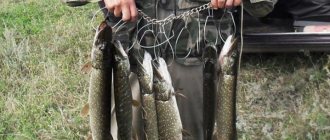Step-by-step description of the stages of manufacturing two types of feeders:
- from a stainless steel tablespoon;
- made of pure lead and wire.
Tools and materials used
The list of materials and tools you will need is short. In order to make a homemade spoon feeder, you must have:
- one stainless steel tablespoon;
- stainless steel strip;
- ring, swivel, carabiner;
- lead;
- soldering iron;
- Bulgarian;
- drill;
- hammer.
You can get a stainless steel strip from an old mixer. Its width is 5 mm and thickness is 0.5 mm. And to get pure lead, you need to melt the sheath of the old cable. This material can also be found in the battery.
Selection of material for the production of spinners
Any spoon is suitable for creating bait, be it a table spoon, a tea spoon or its dessert version. The size only gives additional opportunities in creating products for catching different types of fish. For example, a tablespoon will make an ideal size spoon for pike and catfish, and a dessert spoon will be perfect for catching perch and pike perch.
There are no special requirements for the workpiece material. Items made of stainless steel, aluminum alloys and pure steel options with various coatings of their base are quite suitable for work. The only difference may be the need for additional shipment of light alloy products. This problem can easily be solved by soldering the recess of the cutlery with a small mass of lead or by riveting additional material.
Making a feeder for donkey and fishing for cyprinids - carp, crucian carp, bream, etc.
Let's get to work. The step-by-step process of assembling the feeder looks like this:
- first, cut off the handle of the spoon using a grinder;
- the stainless steel strip must be leveled with a hammer;
- cut it into two strips, 7-8 cm long and two 5-6 cm long. This should be enough to make an arc out of these stainless strips, and also attach them to a spoon;
- at a distance of 1 cm from the ends of the strips, drill holes with a drill: one at a time from one edge;
- We bend the tape in an arc and attach it to the spoon. We bend their ends inward;
- to attach the strips to the spoon we will use copper rivets;
- match the spoon and ribbons to each other and rive them together;
- We make holes with a drill from the edge of the handle and from the side opposite to it. A ring is threaded into the hole on the side of the handle, and a swivel is attached to it. We knit a leash with a hook onto the tip of the spoon;
- Pour lead into the bottom of a spoon. So we will make this homemade feeder heavier, which helps the fish to self-hook when biting. In order for the lead to hold well, it can also be riveted using a strip of stainless steel.
Spoon donkey feeder
Tools for performing work on creating a spinner
To make spinners from a spoon with your own hands, you need to have some plumbing tools available. To simplify the procedure for performing the work and reduce its cost, we will choose a production option with purely manual equipment. The fisherman will have to have a hacksaw for metal. A hacksaw will be needed to separate the handle from the base of the spoon, scoop it, and, if necessary, give the workpiece a certain shape.
A file with a fine notch, for filing edges and grinding off burrs after drilling holes. Hand drill equipped with drill bits from 1.5 to 3 millimeters. Pliers for shaping and bending the edges of a manufactured product. Mechanic's vice, for reliable fastening of workpieces and safe performance of metalworking operations.
Lead feeder - homemade for carp
There is also another method for making a lead feeder for catching carp using the bottom method. To do this, lead must be rolled out in a tablespoon. The resulting shape is cut off at the edges. Then it is soldered along the contour with copper wire. At the end, wire arms (with a cross-section of 3-4 mm) are soldered to it.
Ready-made tackle made of pure lead
After the most important stage of the process is completed, we proceed to tying the hooks. It is better to use a hook with a “hair” if you are going to catch carp. A boilie or corn is usually attached to this “hair”. In addition, boilies are secured with a special clamp.
How to make a bottom feeder for carp from a spoon and lead
There are a huge number of feeders designed for both feeder and bottom fishing. However, many fishermen understand the pleasure that comes from fishing with the gear that they made themselves. It is a kind of talisman, because it is a unique thing that no fisherman has.
Here we will look at two ways to make a feeder for carp fishing with your own hands. One option will use a tablespoon, while the other will use a feeder made entirely of lead and copper wire.
Materials and tools: - tablespoon (stainless steel); - lead; - carabiner, ring, swivel; - soldering iron; - drill; - hammer; - Bulgarian; — stainless steel strip; - copper wire.
Lead can be found in old batteries or can be obtained from lead-insulated wires. It must first be melted; a tin can is quite suitable for these purposes. As for the stainless steel strip, the author found it in an old mixer. The width of the strip is 5 mm and the thickness is 0.5 mm.
The process of making a spoon feeder:
Step 1. Making the base of the feeder
For these purposes, you need to take a grinder and cut off the handle from the spoon. Now, using a drill, you need to drill holes on both edges of the spoon. They are needed to attach the feeder and leash with a hook. By the way, you shouldn’t throw away spoon handles; they can be used to make excellent spoons.
In addition, you need to drill 2 holes (4 in total) for the arcs.
Step 2. Making arches
The arcs will be made from stainless steel strips. The length of one strip should be 7-8 cm, and the other 5-6 cm. Stepping 1 cm from the edge of the strips, you need to drill holes for attaching future arcs. Well, now all that remains is to bend the strips and attach them to the spoon. The author used copper rivets for fastening.
Step 3. Weight the feeder
In order for the fish to hook itself when biting, the feeder must have a sufficiently large weight. To make it heavier, you need to use lead. To do this, melt it and pour it into a spoon. In order for the lead to hold well, a hole is made through it and the spoon, and then the same copper rivets come into play.
That's all, the feeder is almost ready. All that remains is to install the swivel and tie the leash with the hook.
Another way to make a feeder
In this case, lead and copper wire will be used. To make the body of the feeder, lead is rolled out in a spoon. Subsequently, the edges of the body are sealed with copper wire; in the process, loops are also made for attaching the feeder to the main fishing line and the leash. As for the arcs, they are also made of copper wire.
When fishing for carp, the author recommends using hooks with “hair”. Thanks to this “hair”, boilies, corn or other bait are caught. Boilies are attached to the hair using special clamps. As for corn, the author recommends attaching 4-5 grains per “hair”. That's all, after filling the feeder with food, you can cast and wait for the trophy.
Also, this type of feeder is great for catching crucian carp, but in this case two hooks are used. Leashes are made 10-15 cm long, and for their manufacture it is best to use fluorocrabon. The fact is that the light refraction spectrum of this material is the same as that of water. This means that the fish will not notice such a fishing line in the water. As a result, the fish will think that the bait is floating above the feeder.
Source
This post may contain affiliate links. This means I earn a small commission from links used at no additional cost to you. See my privacy policy for more information.
fish, carp, feeder
Filling with complementary foods and hair attachment with hook and attachment
Homemade lead feeder filled with bait and equipped with five grains of corn on a hair rig
Homemade feeder made from a stainless spoon filled with bait and equipped with a boilie on the hair
Homemade feeder made from a stainless spoon filled with bait and equipped with a boilie on the hair
And if you are going to catch crucian carp, you will need two hooks. For leashes (10-15 cm each) fluorocarbon is well suited. It has a refractive spectrum the same as that of water. Therefore, in a liquid environment this line becomes invisible. As a result, it turns out that the bait seems to float above the feeder.
What is a “nipple” tackle?
Such tackle as a nipple is in good standing with many fishermen. This simple fishing device has a good advantage - when the hook is retracted, the fish is hooked on its own. This allows it to be used by inexperienced fishermen.
The second name is “donka”, since the tackle is well suited for bottom fishing. A reel with fishing line is attached to the rod, at the end of which there is a leash with a sinker. A “nipple” with hooks is attached to this design. A nipple is a feeder that contains bait. The hooks on which the catch is caught can either be completely hidden using foam balls, or the tip can be left visible. When the tackle is thrown into the water, the fish approaches it and begins to suck the bait. But it eats not only complementary food, but also hooks. In this way, the fisherman notices the bite and fishes for the crucian carp.
What gear designs exist? Types of tackle
There are many options for such equipment, although they have the same operating principle. The most popular options are two tackles:
- nipple-spring;
- plug nipple
The feeder in the spring nipple is a metal spring or spiral. In such a feeder there is a load inside, and a fishing line and leashes with hooks are already attached to it. If fishing takes place in still water and at shallow depths, you can refuse the load.
The plug nipple is gaining immense popularity among fishermen with each fishing season. The feeder is a plastic lid that can be used for yogurt or mineral water. A lead disc is attached to the top. There are several holes on the sides of the feeder: one for attaching the base to the fishing line, the others for leashes with hooks.
Types of springs
If the question of choosing materials does not arise with a plug nipple, then a spring nipple can be presented in three options. They differ in shape and size.
- "donut spring"
- “spring-harvester” (conical),
- "crucian carp killer"
- A “donut spring” is a fairly long compression spring, collapsing into a ring, with a base diameter of 1–1.5 cm. And the diameter of the “donut” itself is around 4–5 centimeters. The peculiarity of this design is that the leashes are not attached to the spring itself, but through a special leash. The shape of this gear allows you to conveniently place complementary foods.
- The “harvester spring” has the shape of a small cone. In appearance it resembles a small pyramid. The leashes are attached to the top of the fishing structure. Quite compact and convenient gear.
- “Crucian carp killer” is three springs attached in series, which follow each other. There is one hook on each spring. The length of the leashes should be about 5 centimeters, and the distance between them 12 centimeters. Be sure to place a sinker weighing 20–50 grams at the end of the fishing line.
Attention! Experienced fishermen advise hooking pieces of lard or foam plastic onto hooks. This allows you to increase the buoyancy of the hook, and it is easier for the fish to suck it in along with the porridge.
The principle of operation of the miracle tackle
Like the design itself, the principle of operation is very simple. The fisherman chooses a fishing spot that is a frequent habitat for crucian carp. After the tackle is ready and the complementary food is already in the feeder, it is thrown to a certain depth. The crucian carp, attracted by the pleasant aromas of complementary foods, swims up to the “nipple” and begins to suck it along with its tasty contents.
At the same time, it inevitably gets hooked on one or more hooks hidden inside the bait. The alarm lets the fisherman know that the crucian carp has been hooked, and all that remains is to pull the fish ashore. The advantage of using alarms is that they react precisely when the hook is already in the mouth of the prey.
conclusions
The result is a good and practical do-it-yourself feeder for bottom fishing. It can easily accommodate a considerable amount of complementary food, including homemade catchable carp bait. This invention has been tested more than once. And it managed to prove its effectiveness in carp and crucian carp fishing.
Valery Chebotarev - Specially for Samodelki FISH, Ukraine, Zaporozhye
- In search of the perfect “smaktukha”
- “Nipple” for carp: production, bait, fishing tactics
Advantages and disadvantages
pros
- the nipple does not get caught on the uneven bottom;
- fishing will be successful even if the fishing spot is overgrown with grass;
- practical and rarely gets confused;
- If you approach the manufacture or choice of design correctly, then leashes with hooks will not dangle.
Minuses
It has only one negative feature - in strong currents, the use of such gear is ineffective.
A nipple for crucian carp is one of the most popular and frequently used gear. And no wonder, because it is easy to use, but brings a good catch. The tactics and technique of “sucking” fishing are clear even to beginners, and making such tackle with your own hands is as easy as shelling pears. Try to pay attention to all the recommendations - and then crucian carp will be frequent “guests” on your tables.
Types of homemade spinners
Experienced fishermen love hand-made lures for pike, choosing the ideal bait for specific conditions. It is more catchy and cheaper than ready-made options.
It is important that the imitation baitfish attracts the toothy hunter in appearance and moves naturally in the water.
For the manufacture of devices , brass, stainless steel, copper, lead and tin . They are not deformed , durable and strong, easy to process and polish.
Based on their design and principle of operation, there are 3 types of lures for pike:
- oscillating (oscillators);
- rotating (rotators);
- balance.
All of them are easy to make yourself from scrap materials ; how to do this at home will be discussed.


